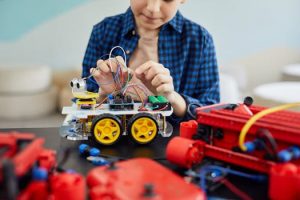Creating Safe Spaces: The Evolution of Inclusive Classrooms
The classroom has always been viewed as a space for learning, growth, and development. However, for many students, it can also be a source of fear, exclusion, and discrimination. Historically, classrooms were not designed to be inclusive of all students, particularly those with disabilities, learning differences, or marginalized identities. But as society has evolved, so has our understanding of the importance of creating safe and inclusive spaces for all individuals. In this article, we will explore the evolution of inclusive classrooms and the steps that educators can take to create safe and empowering learning environments for all students.
The Past: A Lack of Inclusion
In the past, classrooms were primarily designed to cater to the needs of the majority, typically white, able-bodied, and neurotypical students. This limited the accessibility and inclusivity of education for those who did not fit into this narrow mold. Students with disabilities were often excluded from mainstream classrooms and forced to attend separate schools or received no education at all. Moreover, marginalized groups, such as people of color, LGBTQ+ individuals, and those from low-income families, were also often left out and faced discrimination and exclusion within the classroom.
The Shift Towards Inclusion
Fortunately, in recent years, there has been a growing recognition of the importance of inclusive education. The concept of inclusion is based on the belief that all students, regardless of their abilities, identities, or differences, have the right to be educated in a safe, supportive, and challenging environment. This shift towards inclusion has been driven by various factors, including legal mandates, changing societal attitudes, and a growing body of research that supports the benefits of inclusive education.
The Present: The Inclusive Classroom
Inclusive classrooms are designed to meet the diverse needs of all students and create a sense of belonging, acceptance, and respect for every individual. This includes not only accommodating individuals with disabilities or learning differences but also promoting diversity, equity, and social justice in all aspects of education. Inclusive classrooms are not just a physical space but also a mindset and approach to teaching and learning.
Key Components of an Inclusive Classroom
An inclusive classroom is characterized by several key components that contribute to the creation of a safe and empowering learning space. These include:
1. Accessibility
Physical and environmental accessibility is crucial for students with disabilities, ensuring that they can easily navigate and participate in the classroom. This can include features such as wheelchair ramps, assistive technology, and accessible materials. Additionally, it also involves creating an inclusive curriculum that considers the diverse needs and learning styles of all students.
2. Diversity and Inclusion
Diversity and inclusion should be embraced and celebrated in an inclusive classroom. This means acknowledging and valuing the different identities, experiences, and backgrounds of students. It also involves actively addressing issues of discrimination, bias, and prejudice and promoting a climate of respect and understanding.
3. Differentiated Instruction
In an inclusive classroom, instruction is not a one-size-fits-all approach. Teachers must use varied teaching strategies, methods, and materials to meet the needs of diverse learners. This can include visual aids, hands-on activities, and group work, among others.
4. Collaboration and Support
Creating an inclusive classroom also involves fostering a collaborative and supportive learning environment. This can include promoting positive relationships between students, providing individualized support and accommodations, and involving families and caregivers in the learning process.
The Future: A Continued Evolvement
While we have made significant strides towards creating inclusive classrooms, there is still much work to be done. As society and our understanding of diversity and inclusivity continue to evolve, so will our approach to education. This includes the use of technology, innovative teaching methods, and a greater focus on social-emotional learning and cultural competency within the classroom.
The ultimate goal is to create a world where every individual, regardless of their abilities or identities, is provided with equal opportunities to learn, grow, and thrive. Creating safe and inclusive classrooms is a vital step towards achieving this goal and ensuring that education is truly accessible for all.
Conclusion
Inclusive classrooms are essential for creating an equitable and just society. As educators, it is our responsibility to continuously evolve and adopt new practices to ensure that all students feel safe, valued, and empowered within the classroom. By embracing and promoting diversity and inclusion, we can create learning spaces that not only educate students but also shape them into compassionate and inclusive individuals who will make the world a better place.









